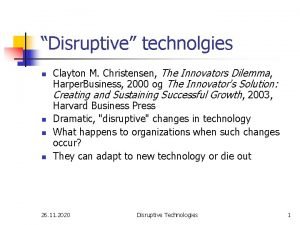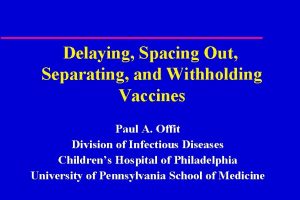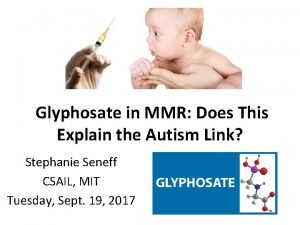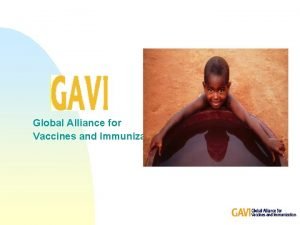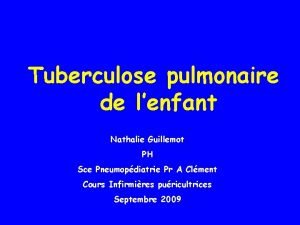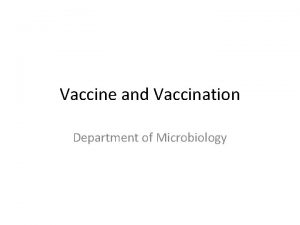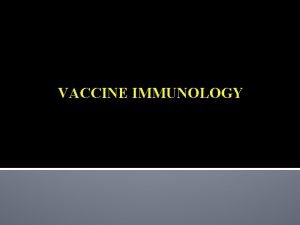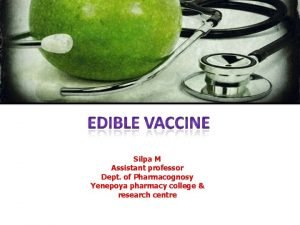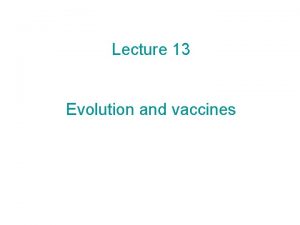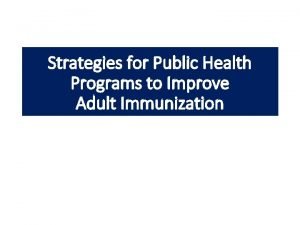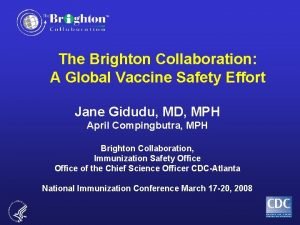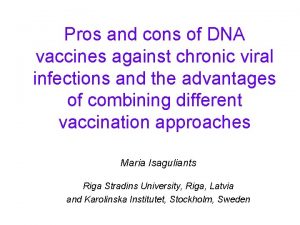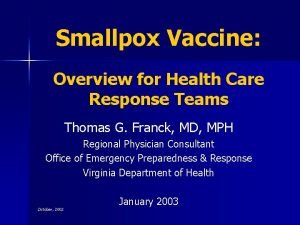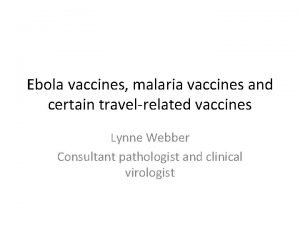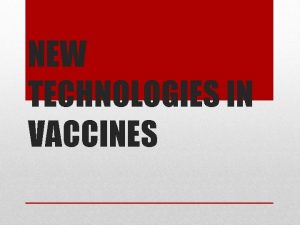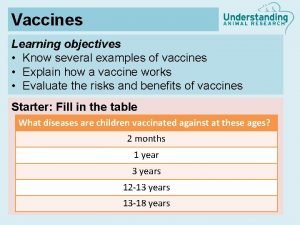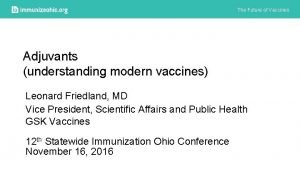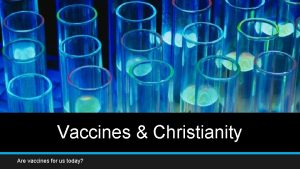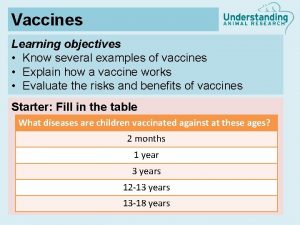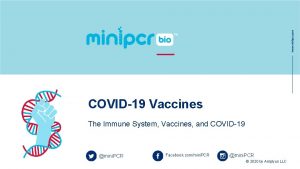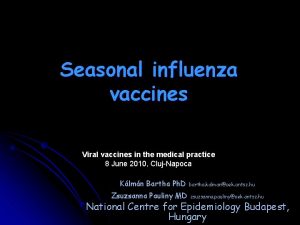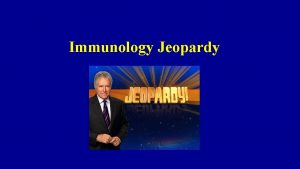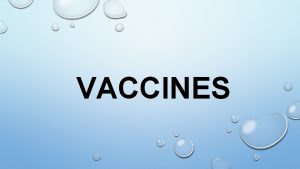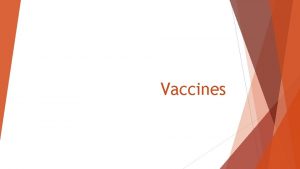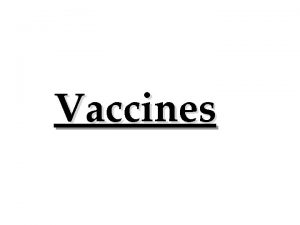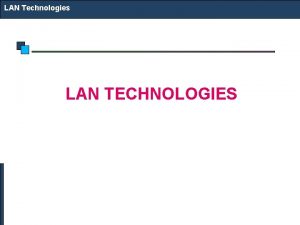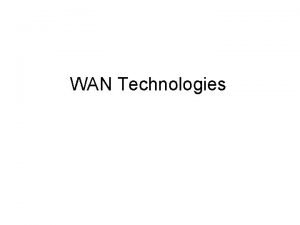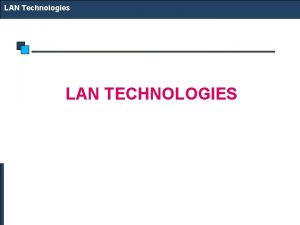New Technologies in Vaccines Vaccines Vaccines induce the

























- Slides: 25

New Technologies in Vaccines

Vaccines � Vaccines induce the body to build immunity to a disease without actually causing the disease itself. � The immune system can recognize proteins that belong to its self (antibodies) and those that are from outside (antigens).

Key Vocabulary �Vaccination is the introduction into the body of a weakened, killed or piece of a disease-causing agent to prevent disease. � Immunization is the process by which the body becomes immune to a disease. A person can become immune by getting the disease or from a vaccination. �An epidemic is when more people in a particular population get a disease than typically expected. � • A pandemic is when a disease outbreak is global or over large areas of the world.

Key Vocabulary �A pathogen is a disease-causing agent. It usually refers to a virus, bacteria, fungi or protozoan parasite. � • A virus is a small, infectious agent that only can replicate inside the cells of a living organism. It has a core of DNA or RNA surrounded by a protein coat and is not itself a living cell.

Key Vocabulary �Bacteria are a large group of microorganisms. They are prokaryotes. While some bacteria cause disease, the majority are harmless, and many are essential to life. �Antigens are substances, usually proteins or polysaccharides, (foreign invaders) that cause the body to produce antibodies. � • Antibodies are special proteins produced by the body to attack foreign invaders such as pathogens

Key Vocabulary �Acquired immunity – Specific immunity that develops after exposure to a particular pathogen �Antibody-mediated immunity – immunity that results from the presence of antibodies in the blood and lymph �Herd immunity – Resistance of a population to the spread of an infectious organism due to the immunity of a high proportion of the population.

Key vocabulary �Immune – Protected from a particular disease either non specific or specific defenses, including the presence of specific antibodies. �Immune response - Response of the body to contact with an antigen that leads to the formation of antibodies and sensitized lymphocytes. Designed to render the antigen harmless.

Key Vocabulary �Lymphocyte – Type of white blood cell. Lymphocytes transmit chemical signals that help coordinate the immune system. �Nonspecific immunity – General defense mechanisms that provide animals with protection from infection and disease but are not targeted at a particular pathogen.

Vaccines �Can you imagine eating a banana instead of getting a shot? �Or using flu vaccine antigens produced by tobacco plants? �Ever heard of vaccine biodefense or nanoprinting new vaccines?

Responding to Pandemics �In 2009, a new strain of influenza emerged that had some characteristics similar to the 1918 flu strain. Health officials were worried. �Could a new strain of flu or some other disease cause a repeat of the 1918 scenario today? � Consider the ways in which the world has changed since 1918. �Do these changes make a deadly disease scenario more or less likely


�When an infectious disease breaks out worldwide, it is called a pandemic. �Influenza, smallpox, bubonic plague and HIV — have caused deadly pandemics. � But because flu viruses include many rapidly changing strains and circulate among animals as well as people, they are particularly likely to cause pandemics. �Our interconnected nature and our current global society only makes these more likely in the future.

�The key weapon and the main goal of vaccination is to prevent disease. �The state of North Carolina requires vaccination against 12 different diseases. �The Centers for Diseases Control and Prevention recommends vaccination against 4 more.

�Vaccination not only protects the vaccinated person but also protects the community as a whole. Herd Immunity � By lowering the incidence of the disease in the population, vaccination protects even those who are too young to be vaccinated, those who are allergic to vaccine ingredients and those who have weakened immune systems. �Researchers are working to solve challenges to develop new vaccines for diseases, including HIV, malaria and chlamydia.

How Vaccinations Work �Your immune system protects you from diseases caused by a wide variety of organisms, including viruses, bacteria, protozoans and worms. �It does this with a layered defense system that includes mechanical barriers (such as skin and mucus) � The purpose of a vaccination is to jump-start a specific immune response by introducing the person (or animal) to enough of a specific disease to cause an immune response , but not the illness.


New Technologies in Vaccines �The foreign proteins are called antigens. �White blood cells recognize surface proteins on disease agents as antigens because they are different from their own body’s proteins Some types of white blood cells, such as macrophages, surround and engulf the invaders by breaking down and displaying the invaders’ surface proteins. This activates the T cells and B cells that make antibodies or proteins shaped to attach to the antigens.

�The antibodies bond with the antigens, which marks them for destruction by macrophages and T cells. �Once the immune system has learned to make antibodies against a particular disease, it makes both T and B memory cells. �These memory cells remain in the body for many years, ready to launch an attack if that specific disease invades again. �Vaccinations work by triggering this response, so the body creates memory cells ready to quickly recognize and destroy a particular pathogen.

�There are several different types of vaccines, each requiring different approaches to design and manufacture. These include: � • Live but weakened disease agents � • Inactivated or killed disease agents � • Subunit vaccines � • Toxoid vaccines � • Conjugate vaccines � • DNA vaccines � • Recombinant vector vaccines

�Many vaccines are made of live, attenuated (weakened) disease agents. (This category includes live virus vaccines. � Even though viruses are not considered living organisms, functional virus particles are called “live. ” �Others vaccines are made of inactivated or “killed” disease agents. � Still others contain only a subunit of the disease organism. �Toxoid vaccines help the body develop antibodies to toxins released by bacteria rather than antibodies to the bacteria themselves.

�Conjugate vaccines help the immune systems of infants, and young children recognize these bacteria by linking toxoids their systems recognize to the polysaccharide coatings. �Two other types of vaccines— DNA vaccines and recombinant vector vaccines — are experimental Each of these types of vaccines provides a different mix of advantages and disadvantages.

�Edward Jenner deliberately infected farmers with cowpox and found them to be immune to smallpox. This vaccination quickly spread around the world, and led eventually to the eradication of smallpox. �In the United States live, attenuated vaccines include MMR, chickenpox and the nasal spray flu vaccine. The advantage of live, attenuated vaccines is that they are very effective in inducing full protection against their diseases.

�Concerns : �The viruses are still “live” and can mutate to a more dangerous form �Some people, especially those with weak immune systems (such as cancer or HIV patients), get sick even from the weakened form of the disease �To remain effective, a live vaccine usually needs constant refrigeration all the way from the manufacturing stage until it is injected into the patient. This is a problem in poor countries.

�The form of the polio vaccine developed by Jonas Salk in the 1950 s used inactivated viruses to induce immunity. �The advantages are: they can’t cause the actual disease, they can be stored without refrigeration, they are cheaper and easier to distribute globally. �The disadvantage is that the immune response they cause is weaker than the live, attenuated viruses. The weaker response means that more booster shots are required to maintain

 Deduce and induce
Deduce and induce Charging by induction permanent
Charging by induction permanent Immigration and urbanization new technologies lesson 4
Immigration and urbanization new technologies lesson 4 New disruptive technologies 2021
New disruptive technologies 2021 New disruptive technologies
New disruptive technologies Cancer vaccines
Cancer vaccines Spacing out vaccines
Spacing out vaccines Hep b vaccines
Hep b vaccines Is glyphosate in vaccines
Is glyphosate in vaccines Global alliance for vaccines and immunization
Global alliance for vaccines and immunization Tubertest lecture
Tubertest lecture Virulent
Virulent What is the difference between vaccination and inoculation
What is the difference between vaccination and inoculation Edible vaccines in pharmacognosy
Edible vaccines in pharmacognosy Edible vaccines pros and cons
Edible vaccines pros and cons Could vaccines breed viciousness
Could vaccines breed viciousness Www.cdc.gov/vaccines/schedules/index.html
Www.cdc.gov/vaccines/schedules/index.html Stephanie seneff mit
Stephanie seneff mit Brighton collaboration
Brighton collaboration Edible vaccines pros and cons
Edible vaccines pros and cons Dna vaccines pros and cons
Dna vaccines pros and cons Freeze market
Freeze market Thể thơ truyền thống
Thể thơ truyền thống Các châu lục và đại dương trên thế giới
Các châu lục và đại dương trên thế giới Bài hát chúa yêu trần thế alleluia
Bài hát chúa yêu trần thế alleluia Hổ đẻ mỗi lứa mấy con
Hổ đẻ mỗi lứa mấy con




